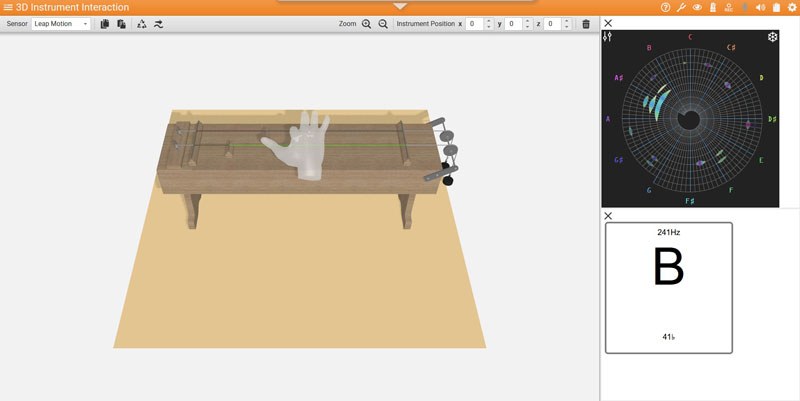by Maximos Kaliakatsos-Papakostas, Kosmas Kritsis, Vassilis Katsouros (Institute for Language and Speech Processing, Athena Research and Innovation Centre)
Combining Science, Technology, Engineering, Arts and Mathematics (STEAM) into a unified pedagogical framework, enables students to directly identify connections between abstract concepts and elements of the real-world. The iMuSciCA project has made the first steps towards developing tools, methods and lesson plans for stimulating creativity in learning and providing the basis for deeper learning. This is achieved with cross-disciplinary lesson plans implemented through the iMuSciCA workbench: an innovative suite of web-based software tools around STEAM.
The iMuSciCA project [L1] (Interactive Music Science Collaborative Activities) has made a first step towards integrating music into STEM (Science, Technology, Engineering and Mathematics) education. iMuSciCA not only brings arts into the heart of STEM, following the paradigm of STEA(rts)M education, but it also combines pedagogy with innovative technologies. The new method introduced by this project has been designed, applied, tested and, whenever necessary, re-adjusted in a real education setting. To this end, iMuSciCA involved a multi-disciplinary team comprising academics, artists and technology experts who co-developed lesson plans alongside an innovative set of interactive STEAM educational tools on a unified workbench [L2].
A novel educational approach
STEAM is an educational paradigm that is gaining ground in the European educational system and iMuSciCA is among the first projects to examine in-depth the implications of STEAM in deeper learning. Until recently, technological education and the arts have been considered as separate subjects, however, bridging the two fields leads to a cross-fertilisation process that benefits learning in both fields. According to the iMuSciCA approach, immense educational dynamics can develop by incorporating creativity, expressed in musical expression and experimentation, in STEM learning environments. In iMuSciCA this is achieved through a web-based workbench [1] that integrates advanced core enabling technologies, including 3D design and printing of musical instruments, body tracking sensors for gesture recognition, interactive pens and tablets as well as sound generation and processing tools.
Various tools have been developed based on the aforementioned technologies that allow users/students to realise and develop connections between and across concepts in music and STEM. This helps students creatively discover laws of physics[2], relations in mathematics and phenomena in engineering and technology. This is achieved by allowing students to move from one field to another with different starting points, practically by changing educational environments inside the workbench, implementing the inquiry-based science education (IBSE) phases, i.e., engage, imagine, create, analyse, communicate and reflect. Some lesson plans have been developed in the context of the iMuSciCA project, but the workbench also enables teachers to be more creative and expressive in their teaching by authoring their own scenarios, leveraging the combined dynamics and the openness of the workbench as well as the ease with which users can jump from one STEAM environment to the other.

Figure 1: The iMuSciCA cross-disciplinary approach, among many other activities, allows the design of virtual 3D virtual instruments using real-world physical quantities, along with informative visualisations of sound (timbre/harmonics) and music.
Expertise and technologies: a cross-discipline consortium
This multi-facet approach to learning could only be achieved by a consortium comprising partners who not only bring unique expertise but are also in a position to understand and develop ideas and technologies across disciplines. ATHENA Research and Innovation Centre focuses on interaction with 3D technologies, but also has expertise in developing educational as well as music software. The University College at Leuven-Limburg (UCLL) developed the overall pedagogical design and evaluation of the outcome of the entire project. Ellinogermaniki Agogi, a private school in Greece, implemented pilot tests and helped in developing lesson plans, involving a multidisciplinary team of teachers (from music to physics). The Institute de Recherche et de Coordination Acoustique Musique (IRCAM) in France developed the real-time sound synthesis algorithm and actuation technology, involving tech experts who are also musicians. Leopoly, a Hungarian SME, contributed with their expertise in 3D interactive object design. Cabrilog from France offered tools for interactive education in mathematics. Spanish WIRIS contributed with their handwriting recognition technologies along with musical tools that took advantage of mathematical formulas and geometric shapes. The University of Fribourg in Switzerland worked on handwriting analysis and workbench integration and, with ATHENA, in deploying biometrics sensors for assessing implications of the iMuSciCA approach in (deeper) learning.
Evaluating the iMuSciCA approach
Research teams in Greece, Belgium and France initially investigated the usability of the iMuSciCA workbench by co-creating lesson plans and educational scenarios with teachers and then conducted pilot studies between November and December 2017. Both teachers and students gave positive feedback along with some comments that were integrated in subsequent versions of the workbench. The final version of the workbench during the time span of the project, included complete localisation with translations on all tools; this, along with the improved usability, allowed for a final pilot testing in two phases from September 2018 to May 2019, to assess the effect of this approach on deeper learning, without the barrier of the UI being presented in a foreign (to non-English speakers) language. The deeper learning evaluation procedure established by the pedagogical team is based on an approach proposed by the Hewlett Foundation and it was based on questionnaires for students and teachers. The results of this study (currently available on [L2]) indicated that the iMuSciCA approach is effective for facilitating deeper learning. Acceptance of iMuSciCA by teachers seems promising, with teachers’ communities forming in the countries involved in the pilot studies.
Links:
[L1] http://www.imuscica.eu/
[L2] https://workbench.imuscica.eu/
References:
[1] K. Kritsis, et al.: “iMuSciCA: A Web Platform for Science Education Through Music Activities”, in Proc. of the Web Audio Conference 2019 (WAC ’19). Trondheim, 2019.
[2] E. Andreotti, R. Frans: “The connection between physics, engineering and music as an example of STEAM education”, Physics Education, 54, 2009. http://doi.org/10.5281/zenodo.3358408
Please contact:
Maximos Kaliakatsos-Papakostas, Vassilis Katsouros, Athena Research and Innovation Centre, Greece











